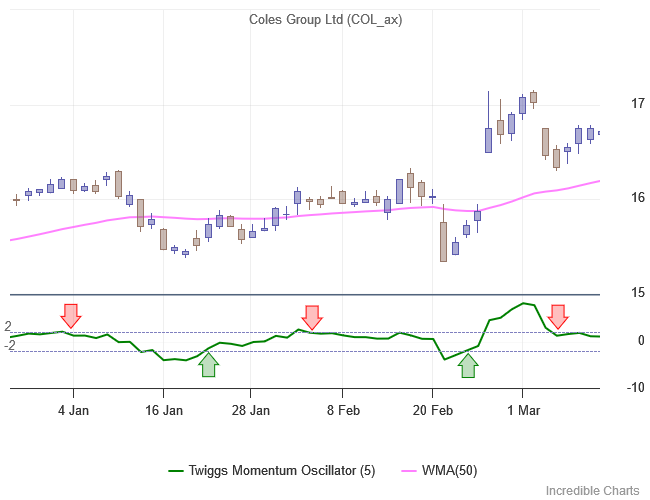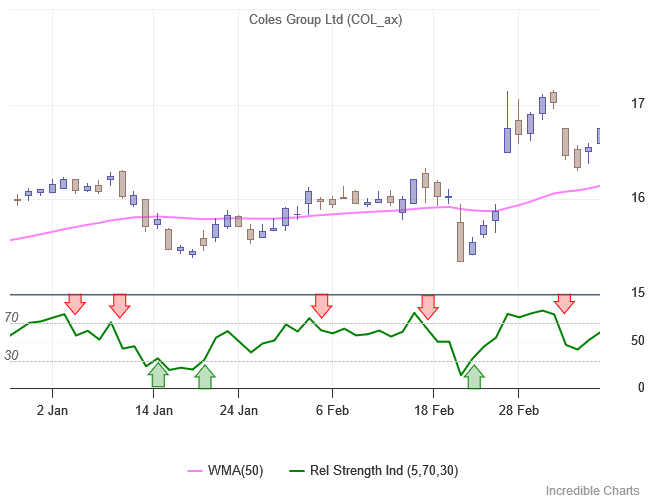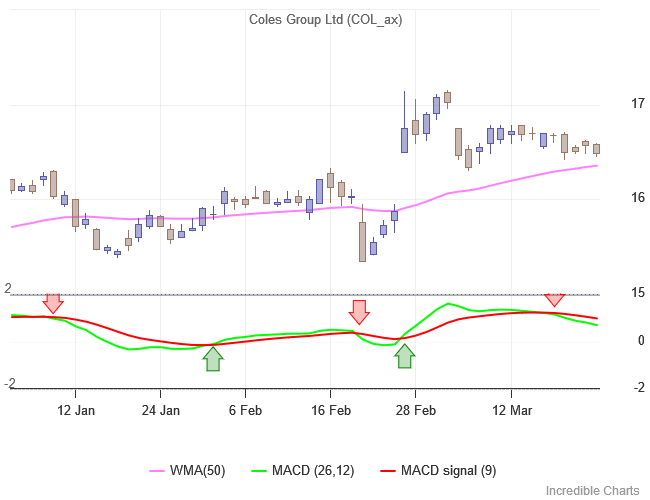Momentum Indicators
Momentum indicators measure the rate of change in price but have three basic weaknesses:
- Momentum tends to be erratic.
- Most momentum indicators suffer from base effects. Unusually high or low prices at the start of the indicator window (e.g. 14 days ago on a 14 day indicator) cause distortion. This is shown in more detail at Momentum.
- Many do not fluctuate between set limits, meaning that Overbought and Oversold levels have to be constantly re-set.
The most commonly used momentum oscillators for trading ranging markets are:
Rate of Change fluctuates as a percentage around the zero line, but the indicator still suffers from the first two weaknesses.
Twiggs® Momentum Oscillator was developed by Colin Twiggs to address these weaknesses, providing smoother and more reliable signals. But the third weakness remains. Overbought and Oversold levels — set at 2 and -2 for Coles Ltd (COL) below — need to be adjusted for each stock depending on volatility.

RSI is also smoother and not as susceptible to distortion but introduces some lag compared to the above two indicators. RSI fluctuates between 0 and 100, providing consistent overbought and oversold signals.
The Stochastic indicator provides an alternative view, comparing closing price to the price range (High minus Low) for the window period. Stochastic movements can be erratic and many traders use the internally-smoothed Slow Stochastic indicator, which they find more reliable. The smoothing again introduces an element of lag.
MACD introduces an element of smoothing, minimizing erratic signals and base effects. But this comes at the expense of lag.
Types of Momentum Indicators
Rate of Change
Rate of change indicators are highly effective for trading ranging markets.
For an in depth analysis of Momentum Trading see our 3-Part Guest Article by Dr Bruce Vanstone.
- Momentum
- Rate of Change (Price)
- Smoothed Rate of Change
- Twiggs® Momentum Oscillator
- Relative Strength Index (RSI)
- Stochastic RSI
- Chande Momentum Oscillator
- Ultimate Oscillator
RSI below shows similar timely entries and exits but with more false starts.

Closing Price relative to Range
Stochastic tends to be erratic, while Slow Stochastic delivers more consistent results but at the expense of additional lag.
Closing price compared to Moving Average
Detrended Price Oscillator works well in a ranging market.
Closing Price relative to High/Low
More volatile.
High/Low compared to Moving Average
Highly volatile.
Moving Average Oscillators
We prefer MACD Percentage Price Oscillator as it provides more consistent overbought and oversold levels. TRIX is triple-smoothed and introduces a lot of lag.
MACD below benefits from greater smoothing, showing fewer erratic signals. But the smoothing introduces more lag as can be seen on the late entry signal on February 27, after Coles Ltd (COL) had already gapped above the 50-day weighted moving average.

Range relative to Previous Range
Range relative to absolute Price Movement
Evaluation
Twiggs® Momentum Oscillator and RSI best address the base effect issue of rate of change indicators, without sacrificing much in the way of lag.
We find Stochastic too volatile, while MACD introduces too much lag.

Author: Colin Twiggs is a former investment banker with almost 40 years of experience in financial markets. He co-founded Incredible Charts and writes the popular Trading Diary and Patient Investor newsletters.
Using a top-down approach, Colin identifies key macro trends in the global economy before evaluating selected opportunities using a combination of fundamental and technical analysis.
Focusing on interest rates and financial market liquidity as primary drivers of the economic cycle, he warned of the 2008/2009 and 2020 bear markets well ahead of actual events.
He founded PVT Capital (AFSL No. 546090) in May 2023, which offers investment strategy and advice to wholesale clients.
